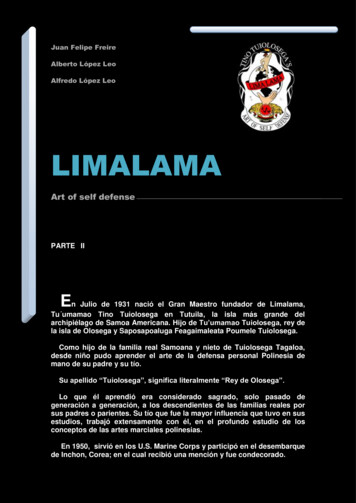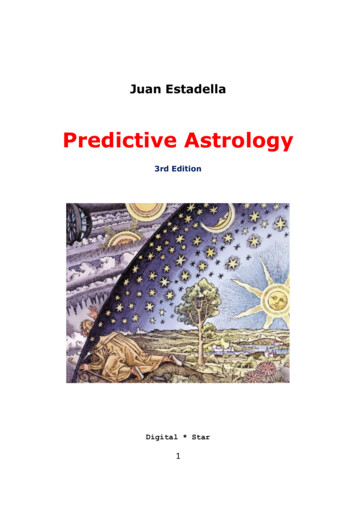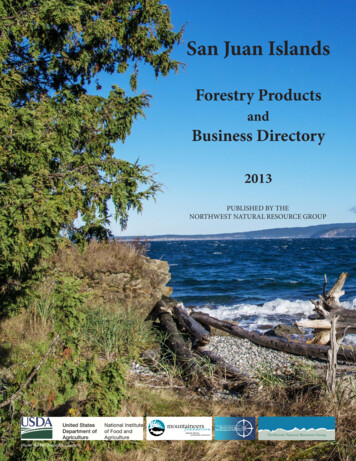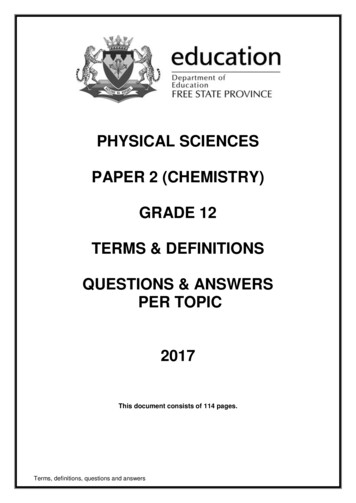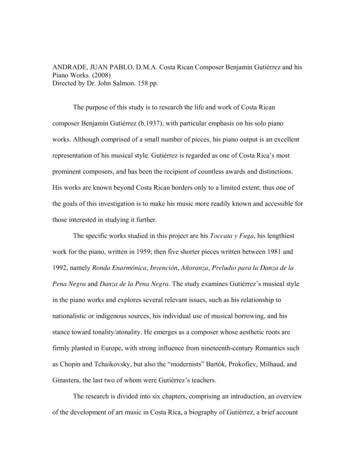
Transcription
ANDRADE, JUAN PABLO, D.M.A. Costa Rican Composer Benjamín Gutiérrez and hisPiano Works. (2008)Directed by Dr. John Salmon. 158 pp.The purpose of this study is to research the life and work of Costa Ricancomposer Benjamín Gutiérrez (b.1937), with particular emphasis on his solo pianoworks. Although comprised of a small number of pieces, his piano output is an excellentrepresentation of his musical style. Gutiérrez is regarded as one of Costa Rica’s mostprominent composers, and has been the recipient of countless awards and distinctions.His works are known beyond Costa Rican borders only to a limited extent; thus one ofthe goals of this investigation is to make his music more readily known and accessible forthose interested in studying it further.The specific works studied in this project are his Toccata y Fuga, his lengthiestwork for the piano, written in 1959; then five shorter pieces written between 1981 and1992, namely Ronda Enarmónica, Invención, Añoranza, Preludio para la Danza de laPena Negra and Danza de la Pena Negra. The study examines Gutiérrez’s musical stylein the piano works and explores several relevant issues, such as his relationship tonationalistic or indigenous sources, his individual use of musical borrowing, and hisstance toward tonality/atonality. He emerges as a composer whose aesthetic roots arefirmly planted in Europe, with strong influence from nineteenth-century Romantics suchas Chopin and Tchaikovsky, but also the “modernists” Bartók, Prokofiev, Milhaud, andGinastera, the last two of whom were Gutiérrez’s teachers.The research is divided into six chapters, comprising an introduction, an overviewof the development of art music in Costa Rica, a biography of Gutiérrez, a brief account
of piano music in the country before Gutiérrez and up to the present day, a detailed studyof his solo piano compositions, and conclusions. Since this music is not readily availableoutside Costa Rica, this paper includes an appendix with all of Gutiérrez’s solo pianopieces, including the author’s editorial suggestions.
COSTA RICAN COMPOSER BENJAMÍN GUTIÉRREZAND HIS PIANO WORKSbyJuan Pablo AndradeA Dissertation Submitted toThe Faculty of The Graduate School atThe University of North Carolina at Greensboroin Partial Fulfillmentof the Requirements for the DegreeDoctor of Musical ArtsGreensboro2008Approved byCommittee Co-ChairCommittee Co-Chair
APPROVAL PAGEThis dissertation proposal has been approved by the following committeeof the Faculty of The Graduate School at The University of North Carolina atGreensboro.Committee Co-ChairCommittee Co-ChairCommittee MembersDate of Acceptance by CommitteeDate of Final Oral Examinationii
TABLE OF CONTENTSPageCHAPTERI.INTRODUCTION . . . . . . . . . . . . . . . . . . . . . . . . . . . . . . . . . . . . . . . . 1Limitations of the Study . . . . . . . . . . . . . . . . . . . . . . . . . . . . . . . 3Status of Related Research . . . . . . . . . . . . . . . . . . . . . . . . . . . . . 4Organization of the Text . . . . . . . . . . . . . . . . . . . . . . . . . . . . . . . 7Procedures . . . . . . . . . . . . . . . . . . . . . . . . . . . . . . . . . . . . . . . . . .7II.ART MUSIC IN COSTA RICA: A HISTORICAL OVERVIEW . . . . 9The Colonial Period . . . . . . . . . . . . . . . . . . . . . . . . . . . . . . . . . . 9The Nineteenth Century . . . . . . . . . . . . . . . . . . . . . . . . . . . . . . 14Early Twentieth Century . . . . . . . . . . . . . . . . . . . . . . . . . . . . . 19The Second Half of the Twentieth Century . . . . . . . . . . . . . . . 27III.BENJAMÍN GUTIÉRREZ: BIOGRAPHICAL OVERVIEW . . . . . . . 35Beginnings . . . . . . . . . . . . . . . . . . . . . . . . . . . . . . . . . . . . . . . . 35Guatemala . . . . . . . . . . . . . . . . . . . . . . . . . . . . . . . . . . . . . . . . 37Marianela . . . . . . . . . . . . . . . . . . . . . . . . . . . . . . . . . . . . . . . . . 39United States . . . . . . . . . . . . . . . . . . . . . . . . . . . . . . . . . . . . . . 42Alberto Ginastera . . . . . . . . . . . . . . . . . . . . . . . . . . . . . . . . . . . 48Composer, Performer, Pedagogue . . . . . . . . . . . . . . . . . . . . . . 54IV.PIANO MUSIC IN COSTA RICA . . . . . . . . . . . . . . . . . . . . . . . . . . . 61V.GUTIÉRREZ’S PIANO WORKS . . . . . . . . . . . . . . . . . . . . . . . . . . . . 68General Aspects of Gutiérrez’s Musical Style . . . . . . . . . . . . . 68Compositional Issues Raised by the Piano Works . . . . . . . . . . 71Toccata y Fuga . . . . . . . . . . . . . . . . . . . . . . . . . . . . . . . . . . . . 77Short Pieces . . . . . . . . . . . . . . . . . . . . . . . . . . . . . . . . . . . . . . 104Musical Style in Añoranza . . . . . . . . . . . . . . . . . . . . . . . . . . 105Musical Style in Preludio para la Danza de la Pena Negra . 110Musical Style in Danza de la Pena Negra . . . . . . . . . . . . . . . 114Musical Style in Invención . . . . . . . . . . . . . . . . . . . . . . . . . . . 118Musical Style in Ronda Enarmónica . . . . . . . . . . . . . . . . . . . 122Summary. . . . . . . . . . . . . . . . . . . . . . . . . . . . . . . . . . . . . . . . . 125iii
VI.CONCLUSIONS . . . . . . . . . . . . . . . . . . . . . . . . . . . . . . . . . . . . . . . .129BIBLIOGRAPHY . . . . . . . . . . . . . . . . . . . . . . . . . . . . . . . . . . . . . . . . . . . . . . . . . . .131APPENDIX. THE WORKS FOR PIANO SOLO OFBENJAMÍN GUTIÉRREZ . . . . . . . . . . . . . . . . . . . . . . . . . . . . . . . . . .136iv
CHAPTER IINTRODUCTIONBenjamín Gutiérrez (b. 1937) is one of Costa Rica’s most celebrated livingcomposers. Born and raised in San José, Costa Rica’s capital and most important city,Gutiérrez also studied music in Guatemala City, Boston, Ann Arbor, Aspen and BuenosAires. Gutiérrez achieved an early success with the premiere of his opera Marianela in1957, when the composer was only twenty years old, and thanks to this event he wasoffered a scholarship to study composition at the New England Conservatory. Histeachers have included Ross Lee Finney, Darius Milhaud and Alberto Ginastera. Hiscompositions range from piano solo and chamber music to orchestral music and opera,and they have been performed in several Latin American countries, the United States,Europe and Japan. He has received many awards and distinctions, among them theNational Prize of Composition in Costa Rica on six different occasions (1962, 1964,1973, 1977, 1980, and 1985). In 1999, La Nación, Costa Rica’s leading newspaper,named him Musician of the Century, and in the year 2000 he was awarded the PremioMagón, the highest distinction bestowed upon an individual for a life dedicated to thedevelopment of culture in Costa Rica.His reputation and musical activities have not been limited to composing; he hasalso been a very active conductor, and a concert and collaborative pianist. In addition, he1
is considered one of the most influential music pedagogues in Costa Rica, havingmentored several students who developed into successful composers in their own right.In spite of his being the most publicly recognized and widely performed of CostaRica’s composers, there is an obvious lack of comprehensive research on his life andwork. This study will attempt to fill that gap partially by accomplishing three objectives:1) providing more biographical documentation of the composer than currently available,2) elucidating particular elements of his compositional style, and 3) studying in detail hiscompositions for piano solo. In order to provide a historical background to Gutiérrez’swork the research also includes a synopsis of the development of art music in Costa Rica,from colonial times through the establishment of the young nation, up to the present.Gutiérrez’s piano output, although small, is an excellent representation of hismusical style. His lengthiest piano solo work is Toccata y Fuga, written in 1959 while theyoung Gutiérrez was studying under Darius Milhaud in Aspen, Colorado. Around tenminutes in length, it earned Gutiérrez an honorable mention at the Aspen Music Festival.The remaining solo works are five short pieces written between 1981 and 1992. Four ofthem were grouped together and published in 1993 under the title Cuatro Piezas paraPiano Elemental. Their individual names are Invención, Añoranza (Nostalgia), Preludiopara la Danza de la Pena Negra, and Danza de la Pena Negra (Dance of Black Grief).Another piece, called Ronda Enarmónica and also bearing the label Piano Elemental,also appeared in 1993 as an appendix to a reprint of the fugue alone from the 1959Toccata y Fuga.2
Besides his solo piano works, Gutiérrez’s most extensive project for the piano isthe Variaciones Concertantes para Piano y Orquesta, written in 1969 and premiered thesame year by the Costa Rica National Symphony with the composer at the piano. Thework has been performed only four times in Costa Rica, three times by the composer assoloist and once by the young Costa Rican pianist Carlos Quesada. In one movement, theVariations are about seventeen minutes in length. This work, however, will not be thefocus of the present study which will concentrate only on his works for piano solo.Gutiérrez has also written concertos for violin, viola, clarinet, flute, saxophone, trombonequartet, bassoon quartet and marimba. A few of these, including the clarinet and violinconcertos, have been performed both in Costa Rica and abroad. Some of the short pianosolo works have also been performed around the world, but the piano variations are notknown beyond Costa Rica’s borders. It is to be hoped that this research will shed light onthe piano works by this major Latin American composer and make their existence knownto musicians in the United States and elsewhere.Limitations of the StudyAlthough a comprehensive biography of Benjamín Gutiérrez is needed, especiallysince he has achieved the stature of a national cultural icon, this treatise will not attemptto accomplish that task. The primary objective of the biographical section of thisdocument will be to provide a context for Gutiérrez’s musical growth. Therefore,investigation of his development as a musician will be detailed, but personal informationand biographical events not clearly related to the development of his compositional stylewill be omitted. Other areas of Gutiérrez’s music, such as chamber music, symphonic3
works or opera are also excluded from this research. Finally, the descriptive approach toGutiérrez’s works presented here emphasizes stylistic traits, historical contexts andinfluences: a detailed theoretical analysis of his works lies beyond the scope of this study.Status of Related ResearchWith the exception of a few newspaper and journal articles and several briefparagraphs in a handful of books, research on the work of Costa Rican, and in fact mostCentral American living composers, has been neglected. Because of Gutiérrez’s status asa national celebrity, local newspapers have often published interviews and articles abouthim, but most of these articles provide little information relevant to a scholarlyinvestigation. At most, they provide a limited amount of information by transcribingGutiérrez’s comments and insights on his own life and music. Antonio Briceño’s onlineinterview for Tiquicia.com is the most comprehensive published to date and contains twosections,1 the first with background information about Gutiérrez and the second with theinterview. The second part of this interview, in five sections, includes Gutiérrez’srecollections of his youth and some of his musical influences, as well as his views onmusical education in Costa Rica and his view of his legacy. Also online, the Costa Ricanconductor Susan Campos, who resides in Madrid, has recently created the BenjamínGutiérrez Sáenz Project, the most extensive website concerning Gutiérrez’s life andwork, as part of her doctoral dissertation at the Universidad Autónoma de Madrid.21Benjamín Gutiérrez, “Maestro Benjamín Gutiérrez,” interview by Antonio Briceño, Tiquicia.com(accessed on 10 September 2006), http://www.tiquicia.com/entrevistas/0008Benjamin/ 2Susan Campos, “The Benjamín Gutiérrez Sáenz Project” (accessed 29 January 2007), /WELCOME.html 4
Although still under construction, Campos’s project already provides a wealth of usefuldata including life chronology, lists of works, biographical material, stylistic observationsand a number of links to material about Gutiérrez and some of his contemporaries.A few journal articles by American scholars also mention Gutiérrez’s work. Themost relevant to the present research is Ronald R. Sider’s 1984 article titledContemporary Composers in Costa Rica, which studies the work of the two leadingcomposers in the country: Benjamín Gutiérrez and Bernal Flores (b. 1937).3 The articleis, to date, the only one to appear in an American music journal that discusses the musicof Costa Rican composers in some detail. Sider himself is also the author of one of themost comprehensive studies of the development of art music in Central America. Hisdoctoral dissertation, The Art Music of Central America: Its Development and PresentState,4 gives detailed accounts of music schools, orchestras, and the most importantcomposers of each Central American country, with analyses of selected works. Inaddition to being a composer, Bernal Flores (born, coincidentally, in the same year asGutiérrez) is also a scholar who has published several books and articles in Costa Ricaabout significant Costa Rican musicians and also about the country’s music history. Hisbook La Música en Costa Rica (1978) is the most comprehensive research available onthe country’s music.5 It provides an overview of Costa Rica’s musical development from3Ronald R. Sider, “Contemporary Composers in Costa Rica,” Latin American Music Review/Revista de Música Latinoamericana, Vol. 5, No. 2, (Autumn-Winter, 1984): 263-276.4Ronald R. Sider, “The Art Music of Central America: Its Develop
Gutiérrez’s piano output, although small, is an excellent representation of his musical style. His lengthiest piano solo work is Toccata y Fuga, written in 1959 while the young Gutiérrez was studying under Darius Milhaud in Aspen, Colorado. Around ten minutes in length, it earned Gutiérrez an honorable mention at the Aspen Music Festival.


